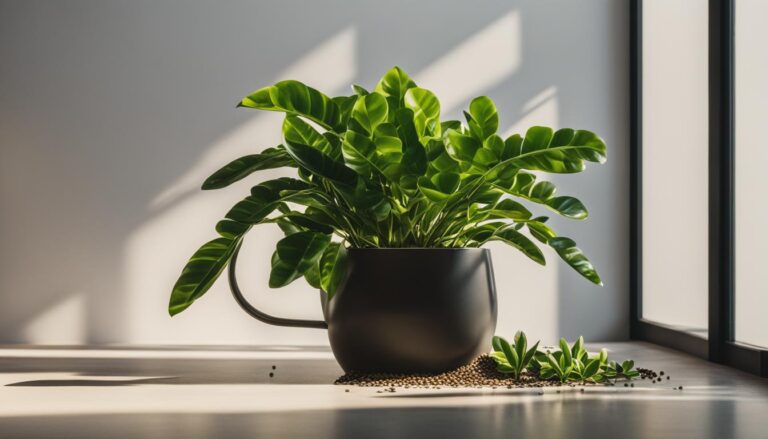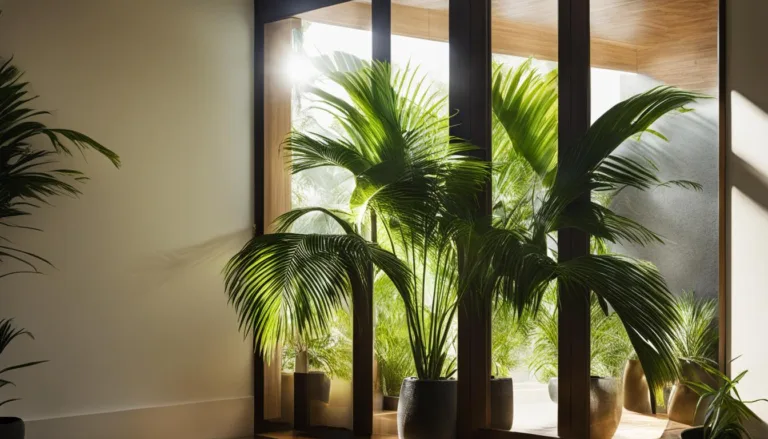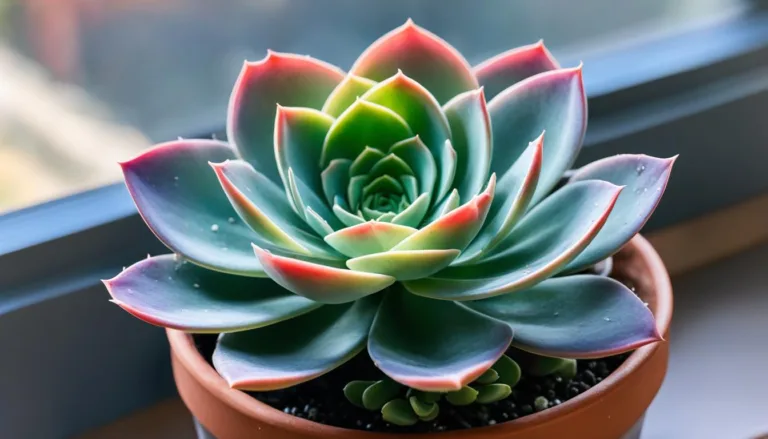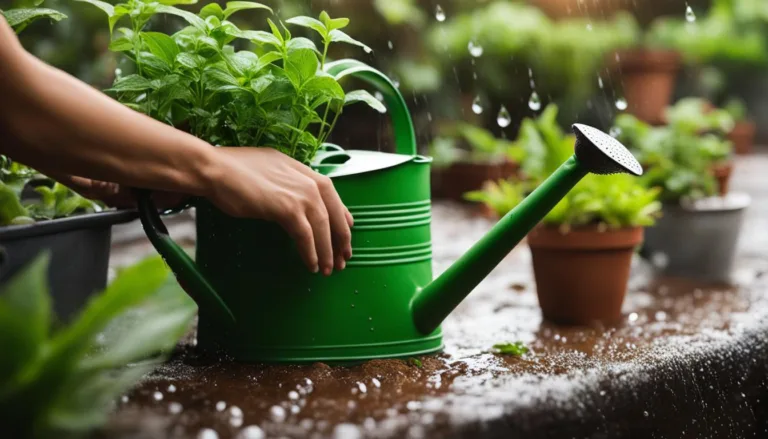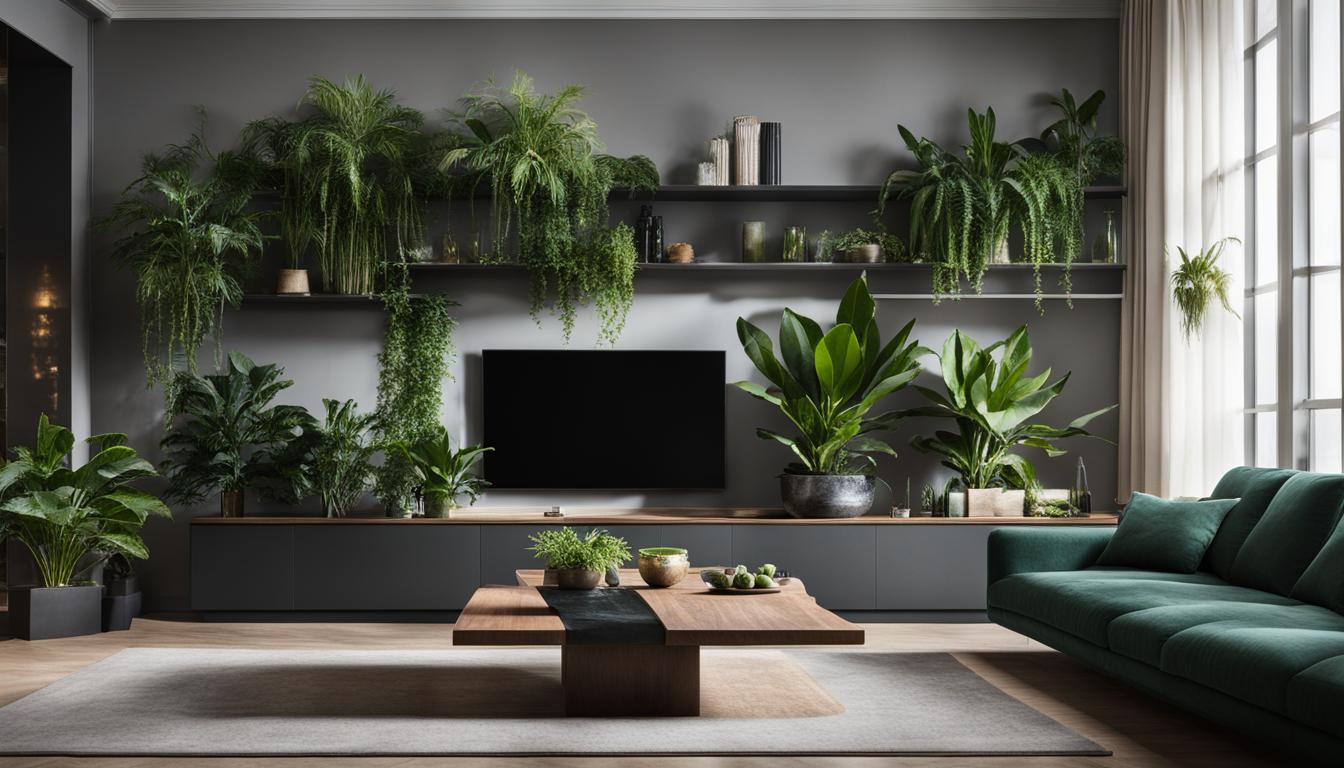
Indoor plants can be a great addition to any home, but for busy individuals, finding the time to care for them properly can be a challenge. However, with a few time-saving tips and the right choice of low-maintenance plants, you can enjoy the beauty of indoor greenery without the worry.
In this article, I will share some easy care tips and suggest low maintenance indoor plants that are perfect for busy individuals.
Key Takeaways:
- Choose low maintenance indoor plants that require minimal care.
- Implement time-saving plant care tips to fit your busy schedule.
- Improve lighting conditions for your indoor plants.
- Start with a small collection of plants and gradually expand.
- Be aware of common plant problems and how to troubleshoot them.
Choose Easy Care Indoor Plants
When it comes to selecting indoor plants that are perfect for busy individuals, it’s important to choose varieties that require minimal maintenance.
Low maintenance indoor plants are not only resilient but also thrive in various conditions, making them an ideal choice for those with a hectic schedule. Here are some easy care indoor plants that are known for their low maintenance needs:
- Snake Plant (Sansevieria) – This plant is well-known for its ability to thrive in low light conditions and requires minimal watering. It also helps purify the air by removing toxins.
- ZZ Plant (Zamioculcas zamiifolia) – The ZZ Plant is extremely forgiving and can tolerate both low light and neglect. It has glossy, dark green leaves and only needs to be watered sparingly.
- Pothos (Epipremnum aureum) – Pothos plants are versatile and can thrive in various light conditions. They require minimal watering and can even be grown in water alone.
- Peace Lily (Spathiphyllum) – Peace Lilies can tolerate low light but also appreciate brighter conditions. They have beautiful white flowers and indicate when they need watering by drooping their leaves.
These easy care indoor plants not only add greenery to your space but also require minimal attention, allowing busy individuals to enjoy the benefits of indoor plants without the added stress of extensive care.
Benefits of Easy Care Indoor Plants
In addition to their low maintenance needs, easy care indoor plants offer several benefits for busy individuals:
- Improved air quality: Many low maintenance indoor plants, such as the Snake Plant and Peace Lily, are known for their air-purifying properties, helping to remove toxins and improve indoor air quality.
- Stress reduction: The presence of indoor plants has been shown to reduce stress and promote a sense of well-being. Having low maintenance plants allows you to enjoy their benefits without adding additional responsibilities.
- Enhanced productivity: Studies have shown that indoor plants can improve concentration and productivity. By choosing low maintenance plants, you can experience these benefits without spending excessive time on plant care.
- Positive aesthetics: Easy care indoor plants add a touch of nature and visual appeal to any space. Their lush green leaves and sometimes even flowers can brighten up a room and create a more welcoming environment.
With these low maintenance indoor plants, you can enjoy the beauty and benefits of indoor greenery while managing a busy schedule with ease.
Care Tips for Busy Individuals
As a busy individual, finding time to care for your indoor plants can be a challenge. However, with some time-saving plant care tips, you can ensure the health and well-being of your green companions without sacrificing your schedule. Here are some care tips specifically tailored for busy individuals:
1. Choose Low Maintenance Plants
When selecting indoor plants, opt for varieties known for their easy care and resilience. Look for plants that require minimal watering, can tolerate low light conditions, and have a forgiving nature. Some popular low maintenance plants include snake plants, pothos, and ZZ plants. These plants can thrive even with sporadic care and are perfect for busy individuals.
2. Create a Plant Care Schedule
Developing a plant care schedule can help you stay organized and ensure that all necessary tasks are completed. Assign specific days for watering, pruning, and fertilizing your plants. Consider using reminders or smartphone apps to help you stay on track with your plant care routine.
3. Optimize Watering Techniques
To save time and prevent overwatering, use bottom watering techniques for your plants. Place your potted plants in a tray of water and allow them to absorb the moisture from the bottom. This can prevent waterlogged soil and reduce the frequency of watering.
4. Invest in Self-Watering Systems
If you often forget to water your plants, consider investing in self-watering systems. These systems can provide a consistent water supply to your plants, reducing the need for constant monitoring. Self-watering pots, watering spikes, and automated irrigation systems are all excellent options to consider.
Implementing these time-saving plant care tips can help you maintain healthy and thriving indoor plants, even with a busy schedule. By choosing low maintenance plants and optimizing your care routine, you can enjoy the beauty of greenery in your home without added stress.
Improve Lighting Conditions
Proper lighting is essential for the health and growth of indoor plants. If you have limited natural light in your home, there are still ways to improve the lighting conditions and ensure the well-being of your plants.
For low light indoor plants, consider placing them near windows that receive indirect sunlight. North-facing windows are a great choice as they provide consistent but gentle light throughout the day.
You can also enhance the lighting by using artificial grow lights specifically designed for indoor plants. These lights emit the right spectrum of light needed for plant growth and can be adjusted based on the requirements of your plants.
On the other hand, if you have bright light indoor plants, make sure to place them near south or west-facing windows where they can receive ample sunlight. However, be cautious as too much direct sunlight can cause leaf burn. Use sheer curtains or blinds to filter the intense sunlight, especially during the peak hours of the day.
| Lighting Conditions | Recommended Placement |
|---|---|
| Low Light | Near north-facing windows or under artificial grow lights |
| Bright Light | Near south or west-facing windows with filtered sunlight |
By improving the lighting conditions for your indoor plants, you can provide them with the necessary energy for photosynthesis and promote healthy growth. Experiment with different placements and observe how your plants respond to find the perfect balance of light for their specific needs.
Start Small and Expand Gradually
If you’re new to indoor plant care or have a busy schedule, it’s best to start with just one or two plants and gradually expand your collection. This allows you to focus your attention and ensure the success of each plant before taking on more.
Starting small also gives you the opportunity to learn about the specific care requirements of each plant and develop a routine that works for you.
When choosing beginner plants for busy individuals, it’s important to consider low maintenance options that can thrive even with minimal care. Some great choices include:
- Sansevieria (Snake Plant): This plant is known for its tolerance of low light conditions and ability to survive with infrequent watering.
- Pothos: Pothos plants are excellent for beginners as they can tolerate a variety of lighting conditions and are forgiving when it comes to watering.
- ZZ Plant: ZZ plants are extremely resilient and can thrive in low light areas with minimal watering.
These beginner plants are not only low maintenance but also add a touch of greenery to your space, improving the overall aesthetic of your home or office.
| Plant | Lighting Requirements | Watering Needs |
|---|---|---|
| Sansevieria | Low to bright indirect light | Allow soil to dry between waterings |
| Pothos | Low to bright indirect light | Allow soil to dry between waterings |
| ZZ Plant | Low to bright indirect light | Allow soil to dry between waterings |
By starting small and choosing beginner plants that are well-suited for busy individuals, you can successfully care for your indoor plants without feeling overwhelmed. As you gain experience and build confidence in your plant care abilities, you can gradually expand your collection and bring more greenery into your space.
Troubleshooting Common Plant Problems

Even with the best care, indoor plants can sometimes encounter problems. It’s important to be aware of common plant issues and understand how to troubleshoot them effectively. Here are some common plant problems and tips for resolving them:
Pest Infestations
Pests like aphids, spider mites, and fungus gnats can wreak havoc on indoor plants. To tackle pest infestations, try the following:
- Inspect your plants regularly to catch any signs of pests early on.
- If you spot pests, gently wipe the affected areas with a damp cloth or use an organic insecticidal soap.
- Isolate infested plants to prevent the pests from spreading.
- Improve air circulation by placing a fan near your plants to deter certain pests.
Yellowing Leaves
Yellow leaves are often a sign of environmental stress or nutrient deficiencies. Here’s what you can do to address this issue:
- Check if your plant is getting the right amount of light. Some plants may need more or less light than others.
- Adjust your watering routine. Overwatering can cause root rot, while underwatering can lead to nutrient deficiencies.
- Fertilize your plants with a balanced, water-soluble fertilizer to provide them with the necessary nutrients.
- Make sure your plant’s pot has drainage holes to prevent water from pooling and causing root problems.
Wilting or Drooping Plants
Wilting or drooping plants are often a sign of underwatering, overwatering, or root issues. Follow these steps to revive your plants:
- Check the soil moisture level by sticking your finger about an inch deep into the soil. If it feels dry, water your plant.
- Ensure proper drainage by using a well-draining potting mix and a pot with drainage holes.
- If you suspect root rot, gently remove the plant from its pot and trim away any affected roots. Repot the plant in fresh soil.
- Provide adequate humidity by misting your plants or using a humidifier in dry indoor environments.
By being proactive and addressing common plant problems promptly, you can help your indoor plants thrive. Remember to observe your plants closely, adjust their care routine as needed, and seek professional advice if necessary. Troubleshooting plant problems is an ongoing process, but with patience and perseverance, you can create a healthy and vibrant indoor garden.
Benefits of Indoor Plants
Indoor plants offer a wide range of benefits for both our physical and mental well-being. Incorporating these green beauties into our homes can have a positive impact on our overall health. Here are some key benefits of indoor plants:
1. Improved Air Quality
Indoor plants are natural air purifiers, as they help remove harmful toxins from the air and release oxygen. They can effectively filter out pollutants such as formaldehyde, benzene, and carbon monoxide, creating a cleaner and healthier indoor environment.
2. Enhanced Mood and Reduced Stress
Spending time around indoor plants has been shown to improve mood and reduce stress levels. The presence of greenery indoors can create a calming and soothing atmosphere, promoting relaxation and a sense of well-being. It has even been linked to increased productivity and concentration.
3. Increased Humidity
Indoor plants naturally release moisture through a process called transpiration. This can help combat dry air and increase humidity in our homes, which is especially beneficial during the winter months or in dry climates. Adequate humidity levels can promote healthier skin, reduce respiratory issues, and prevent dryness and irritation in the eyes and throat.
| Benefits of Indoor Plants |
|---|
| Improved air quality |
| Enhanced mood and reduced stress |
| Increased humidity |
Having indoor plants in our living spaces can bring us closer to nature and provide a sense of tranquility. Their aesthetic appeal, combined with their numerous health benefits, makes indoor plants a worthwhile addition to any home. Whether you’re a busy individual or not, caring for indoor plants can offer a rewarding experience while contributing to a healthier and more vibrant living environment.
Additional Tips for Busy Individuals

As a busy individual, taking care of indoor plants may seem like a daunting task. However, with some time-saving plant care tips, you can easily incorporate plant care into your daily routine. Here are some additional tips for busy individuals:
1. Create a Plant Care Schedule
To stay organized and ensure you don’t forget important plant care tasks, create a plant care schedule. Set specific days and times for watering, fertilizing, and checking your plants for any signs of pests or diseases. You can use a calendar or set reminders on your phone to help you stay on track.
2. Choose Self-Watering Pots
Invest in self-watering pots for your indoor plants. These pots have a built-in reservoir that holds water, allowing the plants to draw moisture as needed. This can help prevent overwatering or underwatering, making it easier to maintain the right moisture levels for your plants.
3. Group Plants with Similar Care Needs
Grouping plants with similar care needs together can make plant care more efficient. This way, you can water, fertilize, and provide other care tasks to multiple plants at once. It also allows you to create mini microclimates, where plants with higher humidity requirements can be grouped together to create a more suitable environment.
By implementing these additional tips, you can simplify indoor plant care and ensure that your plants thrive even if you have a busy schedule.
Avoiding Common Pitfalls
While caring for indoor plants can be a rewarding experience, it’s important to avoid common pitfalls that can hinder their growth and health. By being aware of these mistakes and taking proactive measures, you can ensure that your plants thrive and flourish. Here are some common pitfalls to avoid in indoor plant care:
1. Overwatering
Overwatering is a common mistake that many plant owners make. It’s important to remember that not all plants have the same water requirements. Before watering your plants, check the moisture level of the soil by sticking your finger about an inch deep. If the soil feels damp, wait until it dries out before watering again. Additionally, make sure your pots have drainage holes to prevent water from accumulating at the bottom, leading to root rot.
2. Poor Drainage
Poor drainage can also be a problem in indoor plant care. If your pots don’t have drainage holes, excess water can get trapped, causing root rot and other issues. Ensure that your pots have proper drainage by drilling holes or using pots with pre-existing drainage holes. Additionally, consider using a layer of pebbles or rocks at the bottom of the pot to create a space for water to drain.
3. Lack of Adequate Light
Proper lighting is crucial for the growth and well-being of indoor plants. Many plants require bright indirect light, while others can tolerate lower light conditions. Placing your plants in areas with inadequate light can result in stunted growth, leggy stems, and a lack of foliage. Identify the light requirements of your plants and position them accordingly to ensure they receive the right amount of light.
4. Neglecting Pest Control
Pests can pose a threat to the health of your indoor plants. Common pests such as aphids, mealybugs, and spider mites can infest your plants if not addressed promptly. Regularly inspect your plants for any signs of pest infestation, such as sticky residue, yellowing leaves, or tiny webs. If pests are present, treat them as soon as possible with appropriate organic or chemical pest control methods.
By avoiding these common pitfalls and being attentive to the specific needs of your indoor plants, you can ensure their health and longevity. Remember to tailor your care routine to the individual requirements of each plant and seek advice from gardening professionals or online resources when needed.
Celebrate Your Greenery Success
Caring for indoor plants can bring immense satisfaction and joy, especially when you see your plants thriving and flourishing. As a busy individual, it’s important to appreciate and acknowledge your plant care achievements. Here are some ways to celebrate your greenery success:
Capture and Share
Take photos of your healthy and vibrant indoor plants and share them on social media or with friends and family. This not only allows you to showcase your green thumb but also inspires others to care for plants. You can join online plant care communities and engage in discussions to exchange tips and experiences.
Create a Plant Care Journal
Maintain a journal where you document your plant care routine, observations, and milestones. This can serve as a visual record of your progress and help you track the growth and development of your plants. You can also include any challenges you’ve overcome and the strategies you’ve implemented to address them.
Reward Yourself
Set milestones for your indoor plants and reward yourself when you achieve them. Treat yourself to a new plant or a decorative pot that you’ve been eyeing. This not only adds to your plant collection but also serves as a tangible reminder of your dedication and commitment to plant care.
Remember, celebrating your greenery success is not just about the plants themselves, but also about the positive impact they have on your well-being and the sense of accomplishment you gain from nurturing and caring for them.
Caring for indoor plants doesn’t have to be a time-consuming task, especially for busy individuals. By choosing low maintenance plants and implementing time-saving care tips, you can enjoy the benefits of indoor greenery without added stress.
Remember to start small and gradually expand your plant collection, considering beginner plants that require less attention. Troubleshoot common plant problems promptly to ensure the health and well-being of your plants.
Celebrate your greenery success and acknowledge your plant care achievements along the way. Taking time to appreciate your thriving plants will further enhance your indoor plant care experience.
With a little effort and the right approach, anyone can successfully care for indoor plants, even with a busy schedule. By following these indoor plant care tips, you can create a vibrant and healthy indoor oasis that brings beauty and tranquility to your home.
FAQ
How often should I water my indoor plants?
The frequency of watering depends on the type of plant, the size of the pot, and the environmental conditions. In general, it’s best to let the top inch of soil dry out between waterings. Stick your finger into the soil to check for moisture, and water only when it feels dry.
How much sunlight do indoor plants need?
The amount of sunlight required varies for different plants. Most indoor plants thrive in bright, indirect light, while some can tolerate low light conditions. Assess the lighting in your home and choose plants accordingly. If needed, you can supplement natural light with artificial grow lights.
Do indoor plants need fertilizer?
Indoor plants benefit from regular fertilizing to provide essential nutrients. Use a balanced liquid fertilizer or slow-release granules, following the instructions on the package. Fertilize during the growing season, typically spring and summer, and reduce or stop fertilizing during the winter months when plants are dormant.
How do I prevent pests from infesting my indoor plants?
To prevent pests, regularly inspect your plants for signs of infestation. Wipe leaves with a damp cloth, gently remove any pests you see, and periodically spray plants with an organic insecticidal soap. Isolate infested plants to avoid spreading the pests to other plants.
Can I place indoor plants in the bathroom?
Yes, many plants thrive in the humidity of a bathroom. Choose plants that tolerate low light conditions and can handle moisture, such as ferns, snake plants, and pothos. Ensure adequate drainage to prevent waterlogging.
How do I know if my indoor plants need to be repotted?
If the roots are growing out of the drainage holes, the plant is showing signs of waterlogging, or the pot feels too small for the plant, it’s time to repot. Choose a pot that is slightly larger than the current one and use fresh, well-draining potting soil.
Can I use tap water to water my indoor plants?
Tap water is generally fine for most plants, but some are sensitive to chemicals in tap water. If your tap water contains high levels of chlorine or fluoride, consider using filtered or distilled water for those particular plants.
How do I propagate indoor plants?
There are several methods of propagation, including stem cuttings, leaf cuttings, and division. Research the specific propagation method for your plant and follow the appropriate steps to successfully propagate new plants.
Should I mist my indoor plants?
Misting can provide humidity for certain plants, but it’s not necessary for all. If you have plants that require high humidity, misting can be beneficial. However, avoid misting plants that prefer drier conditions, as it can promote the growth of mold or fungal diseases.
How do I prevent overwatering my indoor plants?
Overwatering is a common issue and can lead to root rot. Ensure your pots have drainage holes and use well-draining soil. Be mindful of the watering needs of each plant and adjust accordingly. Use the finger test to check for soil moisture before watering.

